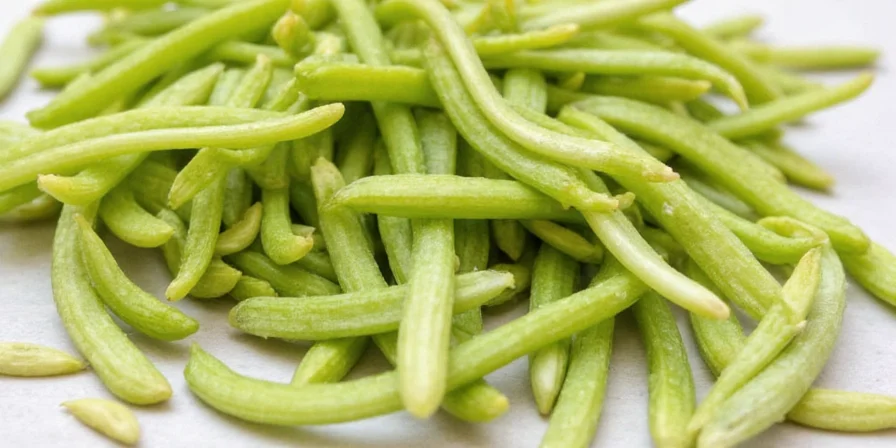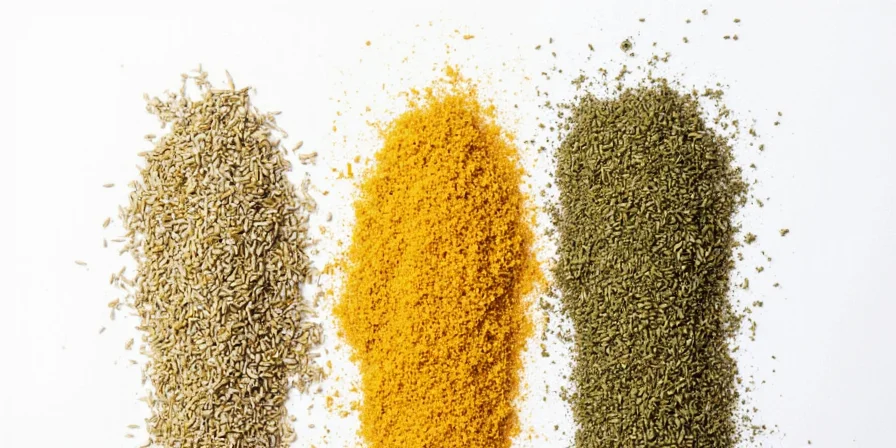Celery seeds come from the mature flowering stage of the biennial celery plant (Apium graveolens). When allowed to complete its two-year growth cycle, the plant produces small white flowers that develop into ribbed seed pods containing the familiar brown seeds used as spice. Unlike the mild-flavored stalks harvested in year one, these seeds contain concentrated essential oils that deliver intense earthy, slightly bitter flavor.
This comprehensive guide explains exactly where celery seeds originate, how commercial and home growers harvest them, and practical culinary applications backed by botanical science. You'll learn the precise harvesting window for maximum flavor, how seed quality compares across growing methods, and professional techniques for incorporating this versatile spice into everyday cooking.
Table of Contents
- What Are Celery Seeds and Where Do They Come From?
- The Science Behind Celery Seed Development
- How Commercial Farms Harvest Celery Seeds
- Growing and Harvesting Celery Seeds at Home
- Celery Seeds vs Stalks: Nutritional and Flavor Differences
- Professional Cooking Applications for Celery Seeds
- Storage Methods for Maximum Shelf Life
- Sustainable Production Benefits of Celery Seeds
- Frequently Asked Questions
What Are Celery Seeds and Where Do They Come From?
Celery seeds are the mature fruits (technically schizocarps) produced by the celery plant during its second growing season. When celery plants are allowed to bolt and flower, they develop small white or greenish-white flowers arranged in umbrella-shaped clusters called umbels. After pollination, these flowers mature into tiny ribbed fruits containing the familiar brown seeds.

Celery seeds come from mature celery flowers - not from the stalks we typically eat
The Science Behind Celery Seed Development
Understanding celery's biennial growth cycle explains why seeds don't come from grocery store stalks:
- First Year Growth: Celery focuses energy on developing edible stalks and leaves. Commercial growers harvest before flowering occurs.
- Vernalization Requirement: The plant needs exposure to cold temperatures (typically winter) to trigger flowering.
- Second Year Flowering: In spring, the plant produces multiple flowering stalks up to 3 feet tall with characteristic umbel formations.
- Seed Maturation: After pollination, each tiny flower develops into a ribbed fruit containing two seeds. The seeds reach peak essential oil concentration when umbels turn from green to brown.
Celery Seed Development Timeline
| Time Period | Development Stage | Key Biological Events |
|---|---|---|
| Months 1-10 (Year 1) | Vegetative Growth | Root and stalk development; no flowering; energy stored in hypocotyl |
| Winter (Year 1-2) | Vernalization | Exposure to 2-10°C for 8-10 weeks triggers flowering response (FAO, 2015) |
| Spring (Year 2) | Flowering Initiation | Umbels form; flowering lasts 4-6 weeks; requires 14+ hour daylight (Cornell CALS, 2022) |
| Late Spring (Year 2) | Seed Maturation | Peak essential oil concentration (1.8-2.5%) at 70-80% browning of umbels (Wang et al., 2019) |
Sources: Food and Agriculture Organization (2015). Celery Production Guidelines. http://www.fao.org/3/y4358e/y4358e06.htm; Cornell University CALS (2022). Celery Flowering Requirements. https://cals.cornell.edu/research/vegetable-program/celery-flowering; Wang et al. (2019). Journal of Food Science and Technology 56(2), 871-878. https://doi.org/10.1007/s13197-018-3546-2
How Commercial Farms Harvest Celery Seeds
Commercial celery seed production follows precise timing to capture maximum flavor compounds:
- Planting Schedule: Farmers plant celery specifically for seed production in late summer, allowing plants to overwinter naturally.
- Harvest Timing: Skilled workers cut seed stalks when 70-80% of umbels have turned brown but before full dryness causes seed shatter (typically late spring).
- Drying Process: Cut stalks undergo controlled drying at 25-30°C (77-86°F) with 40-50% humidity for 7-10 days.
- Seed Extraction: Modern facilities use specialized threshers that separate seeds from chaff with minimal damage to delicate seed coats.
- Quality Sorting: Optical sorters remove discolored seeds, while gravity tables separate by density to eliminate hollow or immature seeds.
Quality Indicator: High-grade celery seeds show uniform brown color with visible oil channels. Pale or speckled seeds indicate improper harvesting or storage.
Growing and Harvesting Celery Seeds at Home
Home gardeners can produce their own celery seeds with proper timing:
- Overwintering Plants: Protect 2-3 celery plants through winter by mulching heavily or moving to an unheated greenhouse.
- Flower Monitoring: Watch for umbel development in spring - seeds reach peak oil content when flower clusters turn brown but remain slightly pliable.
- Harvest Technique: Cut entire seed heads when mature and place in paper bags to catch falling seeds during drying.
- Processing Method: Rub dried umbels between palms over a fine sieve to separate seeds from chaff.
- Storage Preparation: Spread cleaned seeds on a baking sheet for 24 hours before storing to prevent mold.

Commercial celery seed farms time harvest when 70-80% of umbels turn brown
Celery Seeds vs Stalks: Nutritional and Flavor Differences
| Characteristic | Celery Stalk | Celery Seed |
|---|---|---|
| Primary Compounds | Apigenin, phthalides | Limonene, selinene, apiol |
| Flavor Profile | Mild, slightly salty, vegetal | Earthy, warm, slightly bitter with citrus notes |
| Essential Oil Content | Negligible | 1.5-3.0% by weight |
| Shelf Stability | 5-7 days refrigerated | 2-3 years when stored properly |
Culinary Context Boundaries: When to Use Seeds vs Stalks
| Application Scenario | Recommended Form | Key Limitation |
|---|---|---|
| Long-cooked dishes (stews, soups) | Seeds (¼ tsp = 1 stalk) | Exceeding ½ tsp/lb meat causes bitterness (UMass Extension, 2020) |
| Raw applications (salsas, salads) | Stalks only | Seeds develop harsh bitterness when uncooked (McGee, 2004) |
| Low-sodium diets | Seeds (as salt substitute) | Max 1 tsp/day due to apiol toxicity concerns (EFSA, 2012) |
| Crunch texture requirement | Stalks only | Seeds provide zero textural contribution |
Sources: University of Massachusetts Extension (2020). Herbs and Spices Usage Guidelines. https://ag.umass.edu/vegetable/fact-sheets/herbs-spices-flavoring-with-celery-seed; McGee, H. (2004). On Food and Cooking. Scribner, p.402; EFSA (2012). Scientific Opinion on Apiol. https://doi.org/10.2903/j.efsa.2012.2866

Celery seeds contain concentrated essential oils absent in stalks
Professional Cooking Applications for Celery Seeds
Maximize celery seed's culinary potential with these chef-approved techniques:
- Pickling Precision: Use 1 teaspoon seeds per quart of brine for balanced flavor without bitterness
- Meat Enhancement: Combine 1 part celery seed with 2 parts mustard seed for perfect corned beef seasoning
- Flavor Activation: Toast seeds in dry pan 60-90 seconds until fragrant (don't burn) to release maximum essential oils
- Stock Building: Add 1/2 teaspoon seeds to vegetable or meat stocks for umami depth
- Homemade Celery Salt: Grind 2 parts seeds with 1 part fine sea salt for cocktail rimming or seasoning
Flavor Chemistry: Celery seeds' distinctive taste comes from sedanolide and other phthalides that concentrate during seed maturation - explaining why seeds pack more flavor than stalks.

Professional kitchens keep celery seeds in airtight containers away from light
Storage Methods for Maximum Shelf Life
Celery seeds' shelf life depends on proper storage:
- Air Exposure: Oxygen degrades essential oils - transfer store-bought seeds to airtight glass containers immediately
- Light Sensitivity: Amber glass or opaque containers prevent UV damage to volatile compounds
- Temperature Control: Store below 21°C (70°F) - refrigerator storage extends potency by 50% compared to pantry storage
- Humidity Management: Include silica packets to maintain below 60% relative humidity
- Grinding Timing: Whole seeds retain 95% flavor for 24 months vs 6 months for pre-ground versions
Sustainable Production Benefits of Celery Seeds
Celery seed production offers notable environmental advantages:
- Resource Efficiency: Utilizes plants already grown for vegetable production - no additional land required
- Waste Reduction: Converts bolted celery (normally discarded) into valuable spice product
- Water Conservation: Requires no additional irrigation beyond standard celery cultivation
- Carbon Footprint: Local seed production reduces transport emissions compared to tropical spices
- Biodiversity Support: Flowering celery provides nectar for pollinators during early spring when few other plants bloom

Celery seeds enhance flavor complexity in spice blends without artificial additives

Just 1/4 teaspoon celery seeds equals the flavor of one stalk in cooked dishes
Frequently Asked Questions
Where exactly do celery seeds come from on the plant?
Celery seeds develop in the small flowers that form umbrella-shaped clusters (umbels) at the top of flowering stalks. Each tiny flower produces a ribbed fruit containing two seeds. Commercial seed production requires allowing celery plants to complete their two-year growth cycle rather than harvesting stalks in the first year.
Can you get celery seeds from grocery store celery?
No - grocery store celery is harvested during its first growing season before flowering occurs. To produce seeds, the plant must survive winter and flower in its second year. Store-bought celery will eventually bolt if kept long enough, but the resulting seeds lack the flavor intensity of properly matured seeds from plants grown specifically for seed production.
Why do celery seeds taste stronger than celery stalks?
Celery seeds contain 1.5-3.0% essential oils (primarily limonene and selinene) compared to negligible amounts in stalks. These concentrated compounds develop during seed maturation as the plant directs energy toward reproduction. The seeds' small size means these potent compounds deliver intense flavor in minimal quantity - explaining why 1/4 teaspoon seeds equals one stalk's flavor contribution.
How do you know when celery seeds are ready to harvest?
Commercial growers harvest when 70-80% of umbels turn brown but remain slightly pliable. At this stage, seeds have reached maximum essential oil concentration (1.8-2.5%) while remaining attached to the plant. Home gardeners should check daily once flowering begins - the optimal harvest window lasts just 3-5 days before seeds begin shattering. Seeds should detach easily with gentle rubbing when properly mature.











 浙公网安备
33010002000092号
浙公网安备
33010002000092号 浙B2-20120091-4
浙B2-20120091-4